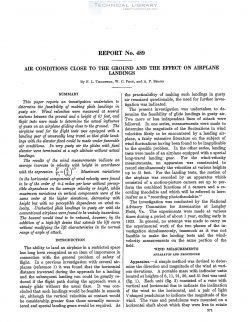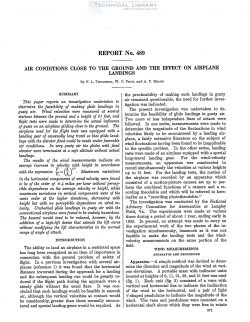naca-report-489

- Version
- 172 Downloads
- 1.14 MB File Size
- 1 File Count
- August 26, 2016 Create Date
- August 26, 2016 Last Updated
National Advisory Committee for Aeronautics, Report - Air Conditions Close to the Ground and the Effect on Airplane Landings

This paper reports an investigation undertaken to
determine the feasibility of making glide landings in
gusty air. Wind velocities were measured at several
stations between the ground and a height of 51 feet, and
flight tests were made to determine the actual influence
of gusts on an airplane gliding close to the ground. The
airplane used for the flight tests was equipped with a
landing gear of unusually long travel so that glide land-
ings with the elevator fixed could be made under favorable
air conditions. In very gusty air the glides with fixed
elevator were terminated at a safe altitude without actual
landings.
The results of the wind measurements indicate an
average increase in velocity with height in accordance
with the expression %n<%)m- Maximum vamat' ions
in the horizontal components of wind velocity were found
to be of the order of :l:4 miles per hour without percep-
tible dependenca on the average velocity or height, while
maximum variations in vertical components were of the
same order at the higher elevations, decreasing with
height but with no perceptible dependence on wind ve—
locity. Unchecked glide landings in gusty air with the
conventional airplane were found to be unduly hazardous.
The hazard would tend to be reduced, however, by the
addition of a high—lift device that emtends the lift curve
without modifying the lifi characteristics in the normal
range of angle of attack.
The ability to land an airplane in a restricted space
has long been recognized as an item of importance in
connection with the general problem of safety of
flight. In a previous investigation with several air-
planes (reference 1) it was found that the horizontal
distance traversed during the approach for a landing
and the subsequent landing run could be greatly re-
duced if the flight path during the approach were a
steady glide without the usual flare. It was con—
cluded that such landings would be feasible in smooth
air, although the vertical velocities at contact would
be considerably, greater than those normally encoun-
tered and special landing gears would be required.
| File | Action |
|---|---|
| naca-report-489 Air Conditions Close to the Ground and the Effect on Airplane Landings.pdf | Download |

Comment On This Post